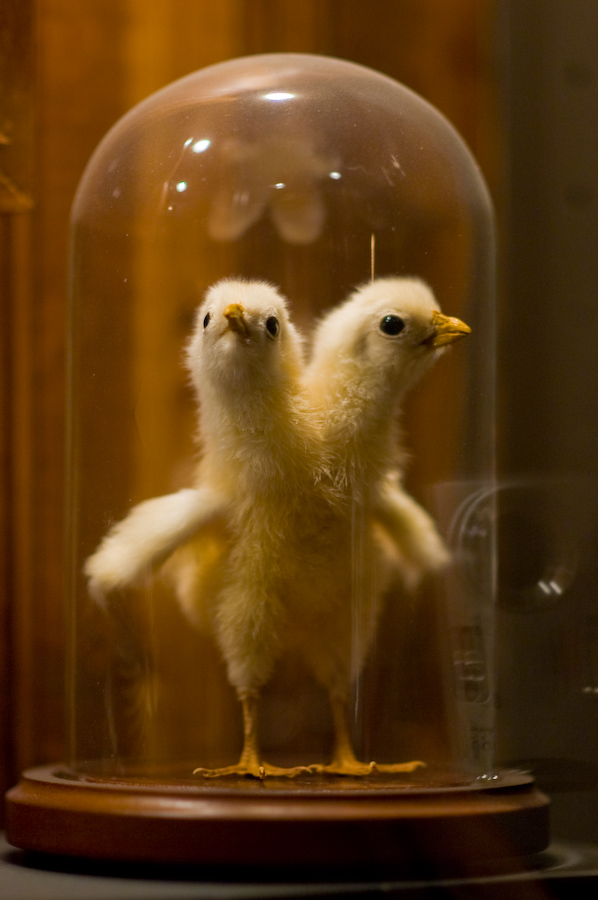 |
| Preservation of a birth defect |
Basic “Types” of Taxidermy
Taxidermic typology may be broken down into a few basic categories:
Trophy or Gamehead Mounts – Gameheads are the type of mounted specimen many would associate with the idea of a hunting lodge. This type of mount is generally just the head, neck, shoulders, and sometimes the breast of a specimen and is usually hung as a plaque(taxidermy.net, 2006). These mounts provide a “face-to-face” encounter with the dead animal, both literally and figuratively. They are a sign of a skilled hunter and direct evidence of death(Desmond, 2002). Trophy mounts may also include prized fish.
Anthropomorphic – Anthropomorphism is when an object possess or is described as having humanistic qualities. It is a form of “anti-naturalistic” taxidermy(Henning, 2007) in that the animal is not preserved in a way as to portray its natural form or mannerisms. The famous Victorian taxidermist Walter Potter stuffed or mounted small animals such as mice who wore clothing and performed human-like activities like sports(Henning, 2007). Potter displayed these creations at Mr. Potter's Museum of Curiosities(Henning, 2007).
| Anthropomorphic taxidermy |
Educational and Natural History Specimens – These are specimens which are preserved for the sake of knowledge, a sort of inventory of species belonging to the same taxonomic group or a specific geographic area. The specimens are used for education about anatomy, to improve species and genus recognition capabilities, knowledge of an animal's habitat and that animal's life(Beard, 1890).
Rogue – Rogue taxidermy is generally used to create fantasy creatures and was once quite popular amongst sideshows of the past. It was often created for the purpose of providing physical evidence of mythical beasts such as the mermaid(also called a Fiji or Feejee mermaid) displayed in London, 1822, which was made using a stitched-together monkey torso and fish tail(Bondenson as cited by Connor, 2009). Many other fictional animals such as the Jackalope and Chupacabra were also used to draw in the curious crowds at sideshows. The Minnesota Association of Rogue Taxidermists is a modern group of artists who still practice this form of taxidermy(Connor, 2009). This type of taxidermy not only includes well known fictitious animals, bu also includes totally random “mash-ups” of animals such as the peakeroo (peacock/kangaroo) and budgericat (budgie/cat)(Connor, 2009).
Pets – Some people choose to have their pet taxidermied instead of cremated or buried. They may wish to display the deceased family member within the home in a favourite past location(Rothfels, 2002). A modern and expensive option for having this type of taxidermy done is through the process of freeze-drying the body in a specific from which can vary in cost from $350 to $3000 and take an extended period of time to complete(Rothfels, 2002). Most taxidermists refuse to work with pets due to the fear of a disappointed client and the fact that the pet's body will be a constant reminder of its previous life(Rothfels, 2002).
 |
| Butterflies in a natural history collection |
The Taxidermic Process
The Initial Goal: To preserve an animal's flesh and to “resurrect” it in as natural and lifelike a manner as is possible(Rothfels, 2002). Birds, fish, and mammals all undergo treatments with similar initial steps but birds and fish require that additional techniques be applied prior to completion(taxidermyhobbyist.com, 2013). Skin and other keratin tissues, hair, fur, and sometimes bone, is preserved.
1) First and foremost, the taxidermic process requires that an animal be deceased prior to beginning the procedure. Early taxidermy manuals teach that all marks of death must be removed; bullets are taken out and the entry wound is cut in a horizontal manner before being stitched to provide a clean and invisible seam(Rothfels, 2002). These early manuals also recommend suffocation of wounded animals in order to maintain the integrity of the body if future taxidermic work is intended(Rothfels, 2002). Blood stains are sponged away and then the nose, mouth, and shot-wound are stuffed with cotton to maintain form and prevent further bleeding(Beard, 1890). The animal may be relocated to a cool area until one is ready to skin it(Beard, 1890) in order to prevent any insect invasion or decomposition.
2) An animal must be measured prior to skinning in order to ensure a form will fit inside. Measurements are taken from top to bottom, including girth, while following the curvature of the animal's body(Beard, 1890). The animal, with eyes already removed, is skinned and then cleaned of all remaining sinew, muscle fibres, and fats prior to preservation(taxidermyhobbyist.com, 2013). Traditionally, the macerated bones and cleaned interior of the carcass would be painted with arsenical soap(Beard, 1890) as a form of chemical preservation. More modern chemicals may currently be in use. Hides may also undergo a tanning process.
 |
| Animal skins |
3) Next comes the “stuffing”. Traditionally, the bones are put back inside the body and a form is created from excelsior shavings or straw, wire, and cotton(Beard, 1890). The wire is then fed along the leg bones through ball of foot and into the artificial body(Beard, 1890). Cotton is also wrapped around the bones and wire for full-looking thighs or necks; it is also stuffed in the throat for the appearance of roundness (Beard, 1890). Modern taxidermist use polyurethane mannequin forms that the skin can be stretched over after having preserved the hide (taxidermyhobbyist.com, 2013). Polyurethane is much more resilient to future weathering than both excelsior shavings and straw.
4) When it comes to the eyes of the animal, removal is necessary. In the past, eyes would be removed and stuffed rounded with cotton which the eyelids would be stretched over(Beard, 1890). Glass eyes are the modern standard(taxidermyhobbyist.com, 2013). These artificial eyes can appear quite realistic.
No comments:
Post a Comment